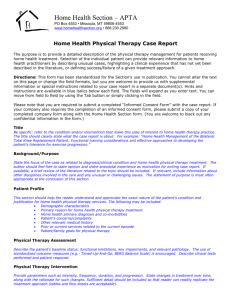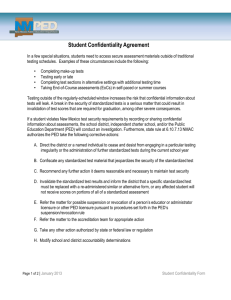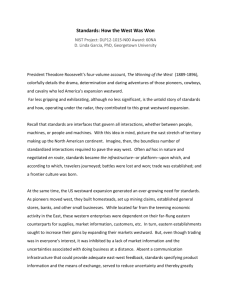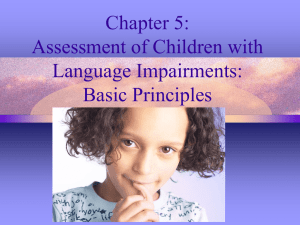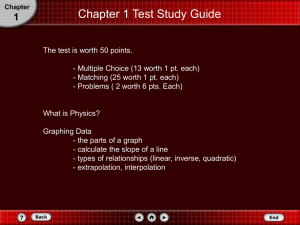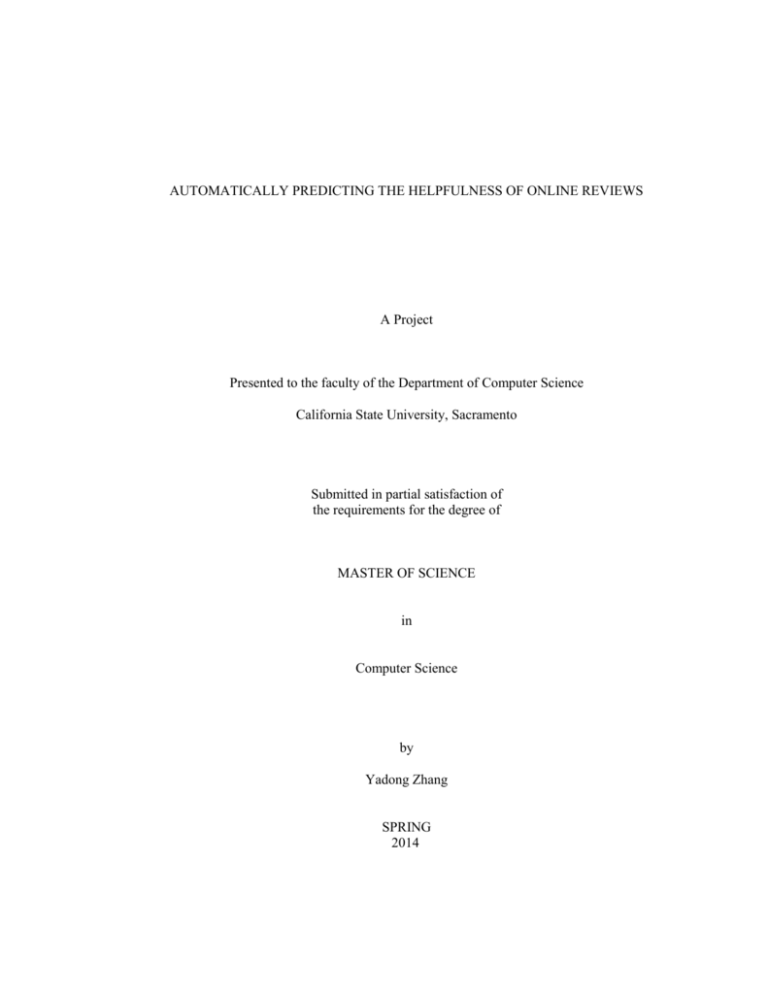
AUTOMATICALLY PREDICTING THE HELPFULNESS OF ONLINE REVIEWS
A Project
Presented to the faculty of the Department of Computer Science
California State University, Sacramento
Submitted in partial satisfaction of
the requirements for the degree of
MASTER OF SCIENCE
in
Computer Science
by
Yadong Zhang
SPRING
2014
© 2014
Yadong Zhang
ALL RIGHTS RESERVED
ii
AUTOMATICALLY PREDICTING THE HELPFULNESS OF ONLINE REVIEWS
A Project
by
Yadong Zhang
Approved by:
__________________________________, Committee Chair
Dr. Du Zhang
__________________________________, Second Reader
Dr. V. Scott Gordon
____________________________
Date
iii
Student: Yadong Zhang
I certify that this student has met the requirements for format contained in the University
format manual, and that this project is suitable for shelving in the Library and credit is to
be awarded for the project.
__________________________, Graduate Coordinator
Dr. Nikrouz Faroughi
Department of Computer Science
iv
___________________
Date
Abstract
of
AUTOMATICALLY PREDICTING THE HELPFULNESS OF ONLINE REVIEWS
by
Yadong Zhang
Online shopping websites provide platforms for consumers to review products and share
opinions. Online reviews provided by the previous consumers are major information
source for both consumers and marketers. However, a large number of reviews for a
product can make it impossible for readers to read through all the reviews in order to
collect information. So it is important to classify and rank the reviews base on their
helpfulness to make them easily accessed by readers. It will help consumers finish their
information search and decision making more easily. It will also be valuable for product
manufactures or retailers to get informative and meaningful consumer feedbacks.
Due to the lack of editorial and quality control, the reviews of product dramatically vary
on quality: from very helpful to useless and even spam-like. The helpfulness of reviews is
currently assessed manually by the votings from readers. This project experiments with
data collected from Amazon through using a supervised machine learning approach to
v
investigate the task of predicting the helpfulness of online reviews. It discusses the
determinants of the helpfulness of online reviews. Eventually it proposes a model which
is used to automatically predict the helpfulness of online reviews.
_______________________, Committee Chair
Dr. Du Zhang
_______________________
Date
vi
ACKNOWLEDGEMENTS
I take this opportunity to thank Dr. Zhang for his guidance and support, his suggestions and ideas
were very essential for the successful completion of this project. I would also thank my parents
for their endless love and support throughout my life.
vii
TABLE OF CONTENTS
Page
Acknowledgements ........................................................................................................................ vii
List of Tables ................................................................................................................................... x
List of Figures ................................................................................................................................. xi
Chapter
1. INTRODUCTION ..................................................................................................................... 1
2. BACKGROUND ....................................................................................................................... 2
3. RELATED WORKS ................................................................................................................. 6
4. DATA PREPARATION ........................................................................................................... 8
4.1. Data set .............................................................................................................................. 8
4.2. Data collection ................................................................................................................... 9
4.3. Data pre-processing ......................................................................................................... 11
4.3.1. Handling missing value ........................................................................................... 11
4.3.2. Data cleaning ........................................................................................................... 11
4.3.3. Data reduction.......................................................................................................... 11
4.3.4. Data transformation ................................................................................................. 12
4.4. Features extraction........................................................................................................... 13
viii
4.4.1. Features from review ............................................................................................... 13
4.4.2. Features from reviewer ............................................................................................ 16
4.4.3. Features from meta data........................................................................................... 16
5. DATA MINING ...................................................................................................................... 18
6. EVALUATION AND DISCUSSION ..................................................................................... 20
7. CONCLUSION AND FUTURE WORK ................................................................................ 25
Appendix A: Information of the product from the data set ............................................................ 26
Appendix B: Source Code ............................................................................................................. 29
preprocessing.r ..................................................................................................................... 29
sentiment.r ............................................................................................................................ 29
DataDetails.java ................................................................................................................... 30
TextMining.java ................................................................................................................... 34
Appendix C: Classifier output ....................................................................................................... 40
Bibliography .................................................................................................................................. 49
ix
LIST OF TABLES
Tables
Page
1. The ratio of reviews with votes ................................................................................................. 5
2. Classification from the percentage of helpful votes ................................................................ 13
3. Feature list ............................................................................................................................... 21
4. Accuracy from different feature combinations........................................................................ 22
x
LIST OF FIGURES
Figures
Page
1. Example of an Amazon review ................................................................................................. 4
2. Distribution of review helpfulness vote count ........................................................................... 5
3. Definition of data fields in data crawling ................................................................................ 10
4. Command to run Scrapy project .............................................................................................. 10
5. Screen shot of crawled data file............................................................................................... 10
6. Sentiment features calculation ................................................................................................. 15
7. Configuration of SMO Model ................................................................................................. 19
8. Evaluation summary ................................................................................................................ 21
9. Distribution of label class ........................................................................................................ 24
xi
1
Chapter 1
INTRODUCTION
Online reviews are a type of product information created by the users based on personal
usage experience. Online shopping websites provide platforms for consumers to review
products and share opinions. Many consumers rely on online reviews for firsthand
information to make purchase decisions. However, a large number of reviews for just one
single product have made it impossible for consumers to read through all the reviews and
evaluate the true quality of a product. Besides, the quality and the helpfulness of each
review also vary. The abundance of the reviews and their uneven quality make it hard for
potential consumers to distinguish between useful and useless reviews.
In this project, we focus on modeling the helpfulness of consumer reviews. According to
the helpfulness estimation, our regression model assigns each review to one of the five
target classes -Extremely Helpful, Very Helpful, Somewhat Helpful, Not very Helpful,
Not at all Helpful. The remainder of this paper is organized as following. Chapter 2
introduces the background of this project. Chapter 3 discusses related work. Chapter 4
and Chapter 5 present our proposed approach. The experimentation and evaluation are
shown in Chapter 6. Finally Chapter 7 concludes the paper and outlines some future
research directions.
2
Chapter 2
BACKGROUND
Online reviews are a type of product information created by the user based on personal
experience. A review can cover: the product features, the shipping speed, the feedback of
the customer service and the comparison to other products. Online shopping websites
provide a platform for consumers to review products and share opinions. For instance,
Amazon.com has one of the most popular forums for user generated reviews. To start to
review a product, a reviewer is first asked to use number of stars to indicate the overall
product assessment. This star scale is from one to five, with five stars being the best -"I
love it" and one being the worst -"I hate it". After the rating, reviewers are asked to
provide detailed information about the product and the explanation of the rating.
Reviewers are suggested to explain why they like or disliked the product; compare the
product to similar products; identify specific attributes and whether the product meets
their expectations. Here are two examples of review from Amazon:
“In this review, I will focus on a feature that has not been covered well by
other reviewers. There a few things you need to do to make it work. Firstly
you have to enable the HDMI-CEC feature on your TV. HDMI-CEC is
marketed under different names by different manufacturers…” (79 of 93
people found this review helpful)
“I don't have it, and won’t be getting it. It appears to be another canned apps
streaming device. I had Google TV. Content was limited on google tv, and
3
streaming from chrome tabs is in beta, and reported not to work very well…”
(1 of 76 people found this review helpful)
A helpful review likely possessed the following characteristics:
It provides a large quantity of detailed information about the product. For instance, in the
first review in the above example, it not only gave information about how to set up the
device, but also focused on the opinions that are different from other product description
or reviews. Also, the sentence structure is clear and contains less spelling or grammar
errors. The providers of these reviews tend to be active and received positive feedback
from other consumers. In comparison, the less helpful reviews provide less information
and add no additional value to the reader. Specifically in the second review above, the
writer of that review mentioned that he didn't have experience with using the product he
was reviewing, thus the information he provided was limited and vague.
Due to the lack of editorial and quality control, the reviews of product vary dramatically
on quality: from very helpful to useless and even spam-like. This is a well-known
problem that some leading websites have censor systems to filter the spam reviews.
A popular example of such system is the one used by Yelp. They have a system to
distinguish between genuine reviews which are posted by the real costumers and fake
reviews which are posted by the business owners to boost their reputations[1] . Another
example is “helpfulness vote” function provided by online shopping websites like
Amazon[2], Sephora[3], etc. Consumers can vote a review as being “helpful” or “not
helpful” after they read the review (see Figure 1 for an example). In most of the websites,
4
reviews can be ranked based on the accumulated votes. However, research [4] showed
that this voting function might have three kinds of biases: (1) imbalance vote bias: users
tend to value others' opinions positively rather than negatively, (2) winner circle bias: the
more votes a review gains, the more default authority it would appear to the readers,
which in turn will influence the objectivity of the readers' votes, and (3) early bird bias:
the earlier a review is posted, the more votes it will get. The latest published review will
always be the least voted one. Since consumers are not obligated to vote such reviews,
only a small number of reviews eventually receive sufficient votes.
Figure 1: Example of an Amazon review
As shown in table 2, the metadata of the dataset we used in this project also proved the
existence of the bias of voting system. We collected 94,560 reviews from Amazon.com.
Only 36% reviews from have votes. Among those 34,878 voted reviews, there're over
75% reviews that have only received less than three helpfulness votes. Figure 2 shows the
distribution of the count of the helpfulness vote in our dataset. As a conclusion, newly
written reviews and reviews with fewer votes cannot be evaluated fairly in such voting
system. Therefore, a model to automatically predict the helpfulness of online reviews is
needed. It will be great help for consumers as well as marketers.
5
Table 1: The ratio of reviews with votes
Review#
Review With
Votes#
Ratio
Beauty
15829
6625
41.85%
Electronics
41176
14789
35.92%
Home & Kitchen
12695
4812
37.90%
Health & Personal Care
14113
6129
43.43%
Grocery & Gourmet Food
10747
2523
23.48%
Total
94560
34878
36.88%
Category
vote# = 1
vote# = 2
vote# = 3
vote# = 4
vote# = 5
vote# = 7
vote# = 8
vote# = 9
vote# = 10
vote# = 11
1.05%
2.56%
1.74%
0.88%
1.25%
7.95%
3.38%
46.29%
5.26%
9.43%
20.22%
Figure 2: Distribution of review helpfulness vote count
vote# = 6
6
Chapter 3
RELATED WORKS
Automatically evaluating the quality of online reviews has gradually attracted more and
more attention in recent years. Most previous works[5] [6] [7] [8] [9] have focused on
automatically predicting the quality (helpfulness or usefulness) of reviews by using a set
of observed textual or social features. Textual features include features that are based on
text statistics such as length of the review, the average length of each sentence,
percentage of nouns or adjectives, etc. Social features are information extracted from the
reviewer's social context, such as the number of the reviews posted by this author, the
past average rating for this author, etc. Most of the current works have formulated the
problem of evaluating review quality as a classification problem or a regression problem
using observed features. In[10][11][12], authors proposed classification-based
approaches supervised by the annotated ground truth, which is manually determined by
the feedback from other users regarding their opinion on whether they think the review is
helpful or not. Instead of classifying reviews as helpful or unhelpful, some works also
considered estimating the helpfulness of reviews by using regression models to generate a
quality rating for each review. S. Kim and P. Pantel[6] found that the most useful features
to determine the helpfulness of online reviews were the length of the review, unigrams of
the review and the rating of the product. They trained a SVM regression system to learn
the helpfulness function. To solve the high dimensionality issue of the bag-ofword(BOW) model which is commonly used in mining the textual features, more
researchers[13] also applied different dimension reduction techniques to remove
7
irrelevant, redundant and noisy features in the reviews. Y. Lu[14] demonstrated that
prediction accuracy of text-based classifiers can be greatly improved by using
regularization on social context. However, there are not enough studies focusing on the
social context such as the information about the product and reviewers. In addition, most
existing studies are focusing on reviews for specific categories of product. An approach
to find a general model, which is based on the review context features and social context
features, and is used for predicting the helpfulness of reviews for products from any
categories is needed.
8
Chapter 4
DATA PREPARATION
Data set
In this project, review data was collected from Amazon.com[2]. The reason we chose
Amazon.com is that it has largest number of posted reviews, which ensure us to get a
large sample. In addition, a recent study [15] shows that the data on Amazon.com,
compared to other popular retail website such as Bestbuy.com, Walmart.com, Dell.com,
and Target.com, did not appear to be heavily censored, which helps prevent systemic data
bias. Systemic data bias in this case means the tendency that the reviews are censored by
the website to appear more positive than they were intended. The reviews from
Amazon.com appeared varied level of experience, including extremely negative ones.
We crawled 94,560 product reviews from Amazon.com. The products are from best
sellers' list of following categories:
Beauty
Electronics
Home & Kitchen
Health & Personal Care
Grocery & Gourmet Food
For each record in our dataset, we gathered information on the following variables:
1. Consumer rating: the number of stars a reviewer gives as the overall assessment
of the product.
9
2. Name: the user name of the person who wrote the review.
3. Product review: the full text of the product review.
4. Date: the date on which the review was posted.
5. Reviewers' ranking: the rank of the reviewer, which is posted on Amazon
reviewers' profile page. It is determined by the overall helpfulness of all their
reviews, factoring in the number of reviews they have written[16].
6. Reviewers' helpful vote percentage: the helpful percentage of the votes received
on reviewers' previous reviews.
7. Review number: the number of prior reviews a review's author has written
8. Helpful vote: the number of consumers who have voted the review as helpful.
9. Total vote: the number of consumers who have voted the review.
Data collection
We use an open source web scraping framework Scrapy[17] to crawl data from
Amazon.com. The workflow of the data collection is as following:
1. Define the data items. See the definition of data field in Figure 3.
10
Figure 3: Definition of data fields in data crawling
2. Write Spider to extract the data (see appendix for the source code: products.py).
3. Run the Spider to extract the data. See Figure 4 for the command.
Figure 4: Command to run Scrapy project
4. Review crawled data. Figure 5 shows a screen shot of the CSV data file.
Figure 5: Screen shot of crawled data file
11
Data pre-processing
Handling missing values
When we examined the original data file from web crawling, we found several missing
values in two fields: Name and Reviewers' ranking. For the missing attributes in the
Name field, we filled them all with string: "NAME". We removed the rows in which
Reviewers' ranking are missing.
Data cleaning
We removed duplicated reviews in the data set. We eliminated multiple reviews for a
single user-item pair. These duplicates could be caused by the errors in data transmission
on the internet, due to which same review might have appeared multiple times. Another
possible cause could be that the user's opinion of a product might have changed over
time. In the case of multiple reviews over time, we retained the most recent one and
discarded the rest of them.
We removed special characters which appeared in review text, such as "\, /, :". Those
characters could cause errors in the text mining process.
Data reduction
To ensure the robustness of the regression model and have a more accurate estimate for
the helpfulness function, we only use the reviews which received at least ten votes.
Reviews where less than ten users have voted the review as helpful or unhelpful were
filtered out.
12
To avoid the potential spam reviewer, we filtered out those reviews written by reviewers
who only have published one review and the rating they gave were extreme, such as "1"
or "5". Research[18] has found that fake reviews tend to be more extreme than that of
legitimate reviews. It also proposed a spam filtering model that contains controls for the
number of prior reviews which a review's author has written. According to their study,
reviewers with fewer published reviews are more suspicious as a spammer, especially
those who have published only one review.
Data transformation
To prepare the Date field for the regression model, we transformed the Date field (data
format: "13-Dec-13") to a numeric value which equals to the number of days between the
date when the review was posted and the current date.
At Amazon.com, consumers publish their reviews about products online after they have
purchased or used the products. Once the reviews have been posted, readers can vote a
review as a "Helpful" or "Not Helpful". For a review, its helpfulness can be calculated as
the ratio P of the number of consumers who have voted r as "Helpful" to the total number
of consumers who have voted r [12]:
𝑃=
ℎ
ℎ + ℎ̅
where h is the number of people that will find a review helpful and ℎ̅ is the number of
people that will find the review unhelpful. We model the prediction of review helpfulness
as a classification problem. In order to classify the reviews, thresholds are needed to
13
assign each review from our dataset to the target class. We define the threshold of the
target classes as following:
Table 2: Classification from the percentage of helpful votes
P value
greater than 80%
60% to 80%
40% to 60%
20% to 40%
Less than 20%
Classes (Label)
Extremely Helpful
Very Helpful
Somewhat Helpful
Not very Helpful
Not at all Helpful
After applying the threshold, we removed vote and voteTotal column from our data set.
We replaced them with a label column: comment.
Features extraction
One of the goals in this project is to find out the determinants of the helpfulness of online
reviews. We extracted features from the following three categories: features from
reviews, features from reviewer and features from metadata.
Features from review
Structural features:
Structure features describes structure and the formatting of the reviews. We experimented
with the following structural features:
sentence.count: The number of sentence.
token.count : The total number of tokens of a review. It described the length of a review.
token.per.sentence: The average number of tokens in a sentence. It described average
sentence length of a review.
14
We used the components of Sentence Detector and Tokenizer from Apache OpenNLP
library[19] to complete the structural feature extraction (See the Java source code in
appendix: TextMining.java).
Syntactic features:
The syntactic features capture the linguistic property of the review. We extracted the
following features:
noun.percentage: The percentage of tokens which are nouns
verb.percentage: The percentage of tokens which are verbs,
adjective.percentage: The percentage of tokens which are adjectives
adverb.percentage: The percentage of tokens which are adverbs.
We used POSModel Class from Apache OpenNLP library [19] to complete this task.
POS(Part of Speech) Tagger marks tokens with their corresponding word type based on
the token itself and the context of the token. The OpenNLP POS Tagger uses a
probability model to predict the correct pos tag out of the tag set. The tag set used by this
model is Penn Treebank tag set[20] (See the Java source code in appendix:
TextMining.java).
Semantic Features
The positive or negative sentiment of words in the review is a good indication about the
strength of the opinion of the reviewer. We used tm.plugin.sentiment package in R [21]
to extract the following five features: polarity, subjectivity, pos_refs_per_ref,
15
neg_refs_per_ref, senti_diffs_per_ref. (See the R source code in appendix: sentiment.r)
Figure 6 shows how each semantic feature was calculated:
[22]
Figure 6: Sentiment features calculation
p: Number of positive words
n: Number of negative words
N: Number of words
Readability
We assumed that reviews which are highly readable tend to be more helpful. In the
contrary, reviews with multiple grammatical error and misspelled words are less helpful
for users. We use LanguageTool Java API [23] to implement the language and grammar
check for this task. We use the fraction of the number of errors in the review text and the
number of sentence as the value of feature error.per.sentence. (See Java source code in
appendix: TextMining.java)
16
Features from reviewer
We collected the information of the following features from reviewers' profile page:
reviewerRanking: The rank of the reviewer.
helpfulPercentage: The helpful percentage of the votes received on reviewers' previous
reviews.
reviewNo: The number of prior reviews a review's author has written.
The reason we selected these features lies in the fact that people with better reputations in
an e-commerce community tend to provide more influential discussions making their
reviews more helpful. Reviewers with higher ranking are expected to have better
reputation. Since our goal is to predict the helpfulness of a review, we wanted to examine
whether the past history of a reviewer can be used to predict the helpfulness of the future
review written by the same reviewer. We supposed that reviews from the same author
will have similar quality. A reviewer that writes helpful high quality reviews is likely to
continue writing good reviews.
Features from meta data
Meta-data features are independent of the review text. We selected the following two
features:
rating: Consumer rating.
age: The number of days since the review was posted.
17
As studies such as [6] have shown consumer rating is one of the key features which can
be used to determine the helpfulness of online reviews. We would also like to include it
into our selected features. In addition, we suspected that the time stamp of when review
has been posted also effect the helpfulness of certain reviews. Older reviews might be
more helpful since they might exhaust the aspects worth reviewing, which left less
perspective for newer reviewer to add on, instead of repeating the similar reviews.
18
Chapter 5
DATA MINING
The Support Vector Machine (SVM) is among the best supervised machine learning
algorithms. SVM constructs a decision boundary with the largest possible distance to data
points, which can be used for classification or regression.
We deployed the John Platt's sequential minimal optimization (SMO) algorithm[24] for
training a support vector classifier. This model solves multi-class problem by using
pairwise classification. The predicted probabilities are coupled using Hastie and
Tibshirani's pairwise coupling method[25]. We tested on the development sets various
kernels including Normalized Polynomial Kernel , Polynomial Kernel, Pre-computed
Kernel Matrix Kernel, Pearson VII function-based universal Kernel and RBF Kernel
[26]. The best performing kernel was Polynomial Kernel (See figure 7 for the
configuration and kernel information of our model). We applied this model to our
training set. The complete classifier output can be found in appendix: classifier output.
19
Figure 7: Configuration of SMO Model
20
Chapter 6
EVALUATION AND DISCUSSION
The original dataset was split into training set and testing set, where 66% of the data was
used as training set and remainder was used for testing. The testing set was used to
evaluate the effectiveness of the proposed model. First we used all 18 features (shown in
table 3) as the input of the SVM model. We got an accuracy of 66.6667 % for correctly
classified the test cases. This model has the best performance of precision of 73.3% on
predicting the "Extremely Helpful" cases. By looking at the detailed accuracy by class,
we found out this model has better performance on predicting extreme cases, such as
Extremely Helpful and Not at all Helpful. The accuracy of this model decreased when
predicting more moderate cases, such as Somewhat Helpful and Not very Helpful. Please
see figure 8 as complete evaluation summary.
21
Table 3: Feature list
Features
sentence.count
token.count
token.per.sentence
noun.percentage
verb.percentage
adjective.percentage
adverb.percentage
polarity
subjectivity
pos_refs_per_ref
neg_refs_per_ref
senti_diffs_per_ref
error.per.sentence
reviewerRanking
helpfulPercentage
reviewNo
rating
age
Figure 8: Evaluation summary
We experimented with various combinations of feature sets. Table 3 shows the selected
feature combinations and their corresponding performance.
22
Table 4: Accuracy from different feature combinations
Accuracy
Rating
Helpful
Percentage
Adjective
Percentage
Adverb
Percentage
Error per
Sentence
Review
Number
Subjectivity
Token
Count
68.7339%
68.6047%
68.4755%
68.3463%
68.3463%
68.3463%
68.2171%
68.0879%
67.9587%
67.8295%
67.7003%
67.5711%
67.4419%
67.3127%
67.3127%
67.3127%
Reviewer
Ranking
Age
Results show that the highest performing feature combination consisted of the rating, the
helpfulPercentage and the reviewNo feature sets, which has a precision of 68.7339%.
As we suspected, the reputation of the reviewers is the major determinant of the
helpfulness of online reviews. The feature helpfulPercentage is an indication of the
quality of reviewer's previous reviews and the feature reviewNo shows the quantity of
their previous reviews. The combination of these features reveal the reputation of a
reviewer. Therefore, those two features significantly contribute to higher performance in
our model. We found that syntactical features (noun.percentage, verb.percentage,
adverb.percentage) and semantic features (polarity, pos_refs_per_ref, neg_refs_per_ref,
senti_diffs_per_ref) did not show any significant improvement in system performance.
We found that rating is also one of the most influential features on predicting helpfulness
of reviews. However, this might be caused by the positive bias, manifested by inflated
helpfulness ratings for positive reviews. This positive biasmight misguide consumer to
23
focus only on the reviews that have been labeled as helpful. As shown in figure 9,
consumers tend to rate positive reviews to be more helpful than negative ones.
Compare to the classification model to predict the helpfulness of reviews in study[27],
which has average precision of 62.8833% in training set size of 1,000 and average
precision of 66.9742% in training set size of 10,000, our model has an average precision
of 68.7339% in training set size of 2,276. So our model shows a better performance on
correctly predicting the helpfulness of reviews. In the proposed model from study [28],
classification precision for GPS product from Amazon reviews is 77.7% for not helpful
reviews and 77% for helpful reviews. Among the MP3 Player product reviews, the
precision is 69.7% for not helpful reviews and 72% for helpful reviews, which higher
than the precision of our model. However, the model proposed in the above study is
limited for specific categories of product whereas our model is providing result for
general categories.
24
Figure 9: Distribution of label class
25
Chapter 7
CONCLUSION AND FUTURE WORK
Most websites rely on manual votes from users to measure the helpfulness of reviews. In
this paper, we proposed a model to automatically predict the helpfulness of online
reviews. We crawled review data from Amazon.com and then trained an SVM model to
classify the helpfulness degree of online reviews. Eventually, we applied it to unlabeled
reviews. Our best model achieved an accuracy of 68.7339% on predicting and classifying
the helpfulness of online reviews. We found that reviewer's reputation is the major
determent of the helpfulness of online reviews.
This project can be further extended in several ways. First, we could examine the validity
of our model on larger datasets. We expect our conclusion will hold because this model is
general and applicable to reviews from multiple different product categories. Second, we
can take more characteristics of reviews into consideration, such as the product
categorization and product features mentioned in reviews. Third, we can extend our study
into identifying the spam reviewers and further improve the accuracy of our model. We
can also incorporate collaborative filtering method into this model, to build a
personalized helpfulness prediction model.
26
Appendix A: Information of the product from the data set
Product Name
Review
No
World Pride Hot Lovely Metallic Sweet Lady Hollow Rose Flower Elastic
Hair Band Headband - Gold
HSI PROFESSIONAL 1 CERAMIC TOURMALINE IONIC FLAT IRON
HAIR STRAIGHTENER FREE GLOVE + POUCH AND travel size Argan
Oil Leave In Hair Treatment. WORLDWIDE DUAL VOLTAGE 110v-220v
THE BEST Vitamin C Serum For Your Face Contains 20% Vitamin C +
Amino Complex + Hyaluronic Acid Serum- Potent 20% Vitamin C with 5%
Hyaluronic Acid Will Leave Your Skin Radiant & More Youthful Looking
By Neutralizing Free Radicals. This Anti Aging Serum Will Finally Give
You The Results You've Been Looking For. OZ Naturals is THE MOST
EFFECTIVE C SERUM AVAILABLE!
Hot Sale Beauty Facial Makeup Blender Foundation Puff Sponges Colors by
Random
Nail Art Brushes- Professional Nail Art Brushes- Sable Nail Art Brush Pen,
Detailer, Liner **Set of 3
Rogaine for Men Hair Regrowth Treatment, 5% Minoxidil Topical Aerosol,
Easy-to-Use Foam, 2.11 Ounce, 3 Month Supply (Packaging May Vary)
THE BEST Hyaluronic Acid Serum For Skin - Potent Anti Aging Serum Best Anti Wrinkle Serum With 5% Vitamin C - Our Customers Call It A
Facelift In A Bottle. This Serum Will Plump & Hydrate Dull Skin As It's
Designed To Fill Those Fine Lines & Wrinkles. 100% Pure No Cream Finally An Anti Aging Serum That Actually Does What It Says It Will Do SELLS OUT FAST!
Olay Pro-X Advanced Cleansing System 0.68 Fl Oz, 1-Count
715
Review
With
VoteNo
76
6834
2943
795
675
203
56
946
68
518
445
278
248
2134
835
Aztec Secret Indian Healing Clay Deep Pore Cleansing, 1 Pound
1737
1092
Dotting 5 X 2 Way Marbleizing Dotting Pen Set for Nail Art Manicure
Pedicure, 4 Ounce
1669
187
Anchor Hocking Heritage Hill Glass Cookie/Candy Jar, 1-Gallon
453
189
Brita 35503 Pitcher Replacement Filters, 3-Pack
1365
1102
KRUPS 1500813248 Electric Spice and Coffee Grinder with Stainless Steel
Blades, Black
Black & Decker CHV1510 Dustbuster 15.6-Volt Cordless Cyclonic Hand
Vacuum
Ball Jar Heritage Collection Pint Jars with Lids and Bands, Set of 6
2272
1090
2562
595
514
178
T-fal C798SC64 Ultimate Stainless Steel Copper-Bottom Heavy gauge
Multi-Layer Base Dishwasher Safe Oven Safe 12-Piece Cookware Set,
Silver
Pyrex Prepware 2-Cup Measuring Cup, Clear with Red Measurements
483
301
968
507
Wilton 570-1121 Easy Flex 3-Piece Silicone Spatula Set, Blue
1098
276
27
AcuRite 613 Indoor Humidity Monitor
2048
420
OXO Good Grips Bottle Brush
932
154
Google Chromecast HDMI Streaming Media Player
13846
3832
Kindle Paperwhite, 6" High Resolution Display with Next-Gen Built-in
Light, Wi-Fi - Includes Special Offers
Roku 3 Streaming Media Player
8878
3137
5982
2918
Apple TV MD199LL/A
3563
1355
Sony BDP-S5100 3D Blu-ray Disc Player with Wi-Fi
1266
604
ARRIS / Motorola SurfBoard SB6141 DOCSIS 3.0 Cable Modem - Retail
Packaging - White
Samsung UN32EH5300 32-Inch 1080p 60 Hz Smart LED HDTV (Black)
1718
601
2286
1110
Medialink Wireless-N Broadband Router with Internal Antennas (300
Mbps) - 2.4GHz - 802.11b/g/n - Compatible with Windows 8 / Windows 7 /
Windows Vista / Windows XP / Mac OS X / Linux
Sabrent 4-Port USB 2.0 Hub with Individual Power Switches and LEDs
(HB-UMLS)
Acer C720 Chromebook (11.6-Inch, 2GB)
1935
599
975
141
727
492
Viva Labs #1 Organic Extra Virgin Coconut Oil - 16 oz
1714
348
Keurig, The Original Donut Shop, K-Cup Packs
2733
463
KIND Nuts & Spices, Dark Chocolate Nuts & Sea Salt, 1.4 Ounce, 12Count Bars
Nutiva Organic Chia Seeds, 12-Ounce Bag
940
165
515
227
Quest Nutrition Protein Bar Chocolate Chip Cookie Dough Flavor, 2.12
oz,12 Count
Nature's Way Coconut Oil, 32-Ounce
307
72
682
322
Vita Coco 100% Pure Coconut Water, 11.1-Ounce Containers (Pack of 12)
1459
546
Happy Tot Organic Baby Food, Stage 4, Spinach, Mango and Pear, 4.0Ounce Pouches (Pack of 16)
Annie's Homegrown Berry Patch Organic Bunny Fruit Snacks,0.8 Ounce, 5Count Pouches (Pack of 4)
Grove Square Hot Cocoa, Milk Chocolate, 24 Count Single Serve Cup for
Keurig K-Cup Brewers
392
90
349
101
1656
189
Pampers Sensitive Wipes 7x Box 448 Count
675
76
Quilted Northern Ultra Plush Bath Tissue, 48 Double Rolls (Packaging May
Vary)
Huggies Natural Care Fragrance Free Baby Wipes Refill, 648 Count
(Packaging may vary)
Playtex Diaper Genie Refill, 270 count (pack of 3)
1407
328
371
75
888
126
28
Luvs With Ultra Leakguards Size 4 Diapers 160 Count
948
475
NatureWise Garcinia Cambogia Extract Natural Appetite Suppressant and
Weight Loss Supplement, 180 Count, 500mg
Angel Soft, Double Rolls, [4 Rolls*12 Pack] = 48 Total Count
3389
2575
765
118
Crest 3D White Whitestrips, Professional Effects w/Advanced Seal
Whitening Treatment, 20 Treatments (Packaging May Vary)
Fitbit Flex Wireless Activity + Sleep Wristband, Black
1706
691
3594
1602
Sparkle Paper Towels, 24 Giant Rolls, Pick-A-Size, White
370
63
94560
34878
29
Appendix B: Source Code
preprocessing.r
d <-read.csv("C:\\Users\\someone\\Desktop\\project\\data\\data.csv")
d.sub <- subset(d,(d$reviewNo > 1|(d$rating!=5 & d$rating!=1))& d$voteTotal >10)
age <- (Sys.Date() - as.Date(d.sub$date, format='%d-%b-%y'))
label <- d.sub$vote/d.sub$voteTotal
df <- data.frame(d.sub$rating, d.sub$name, d.sub$review, age, d.sub$reviewerRanking,
d.sub$helpfulPercentage, d.sub$reviewNo, label)
names(df) <- c("rating", "name", "review", "age", "reviewerRanking",
"helpfulPercentage", "reviewNo", "label")
write.csv(df, "C:\\Users\\someone\\Desktop\\project\\R\\df10.csv", row.names = FALSE)
sentiment.r
score <- function (corpus, control, scoreFUNS, replace = TRUE)
{
if (missing(control)) {
control = list(tolower = TRUE, removePunctuation = TRUE,
removeNumbers = TRUE, removeWords = list(stopwords("english")),
stripWhitespace = TRUE, stemDocument = TRUE, minWordLength = 3,
weighting = weightTf)
}
if (missing(scoreFUNS)) {
scoreFUNS = list(polarity = list(), subjectivity = list(),
pos_refs_per_ref = list(), neg_refs_per_ref = list(),
senti_diffs_per_ref = list())
}
tdm <- TermDocumentMatrix(corpus, control = control)
res <- list()
for (n in names(scoreFUNS)) {
args <- unlist(scoreFUNS[[n]])
if (is.null(args)) {
res[[n]] <- eval(call(n, tdm))
}
else {
res[[n]] <- eval(call(n, tdm, args))
}
}
dfres <- as.data.frame(res)
meta <- DMetaData(corpus)
if (replace) {
30
MetaID <- meta$MetaID
meta[, colnames(dfres)] <- dfres
DMetaData(corpus) <- meta
}
else {
DMetaData(corpus) <- cbind(DMetaData(corpus), dfres)
}
corpus
}
d <-read.csv("C:\\Users\\someone\\Desktop\\project\\R\\test10.csv")
d.corpus <- Corpus(VectorSource(d$review))
d.score <- score(d.corpus)
df <- data.frame(d,meta(d.score))
dfd <- df[, which(names(df)!="MetaID" & names(df)!="review" & names(df)!="name")]
dfd.sub <- subset(dfd, polarity!="NaN")
write.csv(dfd.sub, "C:\\Users\\someone\\Desktop\\project\\R\\df_sentiment_c.csv",
row.names = FALSE)
DataDetails.java
public class DataDetails {
String helpfulPercentage = null;
String rating = null;
String name = null;
String review = null;
String age = null;
String reviewerNo = null;
String label = null;
String comment = null;
String reviewerRanking = null;
float sentenceCount = 0;
float tokenCount = 0;
float tokenPerSentence = 0;
float nounPercentage = 0;
float verbPercentage = 0;
float adverbPercentage = 0;
float adjectivePercentage = 0;
float errorPerSentence = 0;
31
public String getComment()
{
return comment;
}
public void setComment(String comment)
{
this.comment = comment;
}
public float getTokenPerSentence()
{
return tokenPerSentence;
}
public void setTokenPerSentence(float tokenPerSentence)
{
this.tokenPerSentence = tokenPerSentence;
}
public float getErrorPerSentence()
{
return errorPerSentence;
}
public void setErrorPerSentence(float errorPerSentence)
{
this.errorPerSentence = errorPerSentence;
}
public float getNounPercentage()
{
return nounPercentage;
}
public void setNounPerventage(float nounPercentage)
{
this.nounPercentage = nounPercentage;
}
public float getVerbPercentage()
{
return verbPercentage;
}
32
public void setVerbPerventage(float verbPercentage)
{
this.verbPercentage = verbPercentage;
}
public float getAdverbPercentage()
{
return adverbPercentage;
}
public void setAdverbPerventage(float adverbPercentage)
{
this.adverbPercentage = adverbPercentage;
}
public float getAdjectivePercentage()
{
return adjectivePercentage;
}
public void setAdjectivePerventage(float adjectivePercentage)
{
this.adjectivePercentage = adjectivePercentage;
}
public float getTokenCount()
{
return tokenCount;
}
public void setTokenCount(float tokenCount)
{
this.tokenCount = tokenCount;
}
public float getSentenceCount()
{
return sentenceCount;
}
public void setSentenceCount(float sentenceCount)
{
this.sentenceCount = sentenceCount;
33
}
public String getHelpfulPercentage()
{
return helpfulPercentage;
}
public void setHelpfulPercentage(String helpfulPercentage)
{
this.helpfulPercentage = helpfulPercentage;
}
public String getRating()
{
return rating;
}
public void setRating(String rating)
{
this.rating = rating;
}
public String getName()
{
return name;
}
public void setName(String name)
{
this.name = name;
}
public String getReview()
{
return review;
}
public void setReview(String review)
{
this.review = review;
}
public String getAge()
{
34
return age;
}
public void setAge(String age)
{
this.age = age;
}
public String getReviewerNo()
{
return reviewerNo;
}
public void setReviewerNo(String reviewerNo)
{
this.reviewerNo = reviewerNo;
}
public String getLabel()
{
return label;
}
public void setLabel(String label)
{
this.label = label;
}
public String getReviewerRanking()
{
return reviewerRanking;
}
public void setReviewerRanking(String reviewerRanking)
{
this.reviewerRanking = reviewerRanking;
}
}
TextMining.java
import java.io.File;
35
import java.io.FileInputStream;
import java.io.FileNotFoundException;
import java.io.FileReader;
import java.io.FileWriter;
import java.io.IOException;
import java.io.InputStream;
import java.io.StringReader;
import java.io.StringWriter;
import java.util.ArrayList;
import java.util.List;
import org.languagetool.JLanguageTool;
import org.languagetool.language.AmericanEnglish;
import org.languagetool.rules.RuleMatch;
import au.com.bytecode.opencsv.CSVReader;
import au.com.bytecode.opencsv.CSVWriter;
import au.com.bytecode.opencsv.bean.ColumnPositionMappingStrategy;
import au.com.bytecode.opencsv.bean.CsvToBean;
import opennlp.tools.cmdline.PerformanceMonitor;
import opennlp.tools.cmdline.postag.POSModelLoader;
import opennlp.tools.postag.POSModel;
import opennlp.tools.postag.POSSample;
import opennlp.tools.postag.POSTaggerME;
import opennlp.tools.sentdetect.SentenceDetectorME;
import opennlp.tools.sentdetect.SentenceModel;
import opennlp.tools.tokenize.Tokenizer;
import opennlp.tools.tokenize.TokenizerME;
import opennlp.tools.tokenize.TokenizerModel;
import opennlp.tools.tokenize.WhitespaceTokenizer;
import opennlp.tools.util.InvalidFormatException;
import opennlp.tools.util.ObjectStream;
import opennlp.tools.util.PlainTextByLineStream;
public class TextMining {
/**
* @param args
*/
public void SentenceDetect() throws InvalidFormatException,
IOException {
36
List<DataDetails> list = new ArrayList<DataDetails>();
list = parseCSVtoBean("df10.csv");
System.out.println(list.size());
//train model for sentenceCount
InputStream is = new FileInputStream("en-sent.bin");
SentenceModel sModel = new SentenceModel(is);
SentenceDetectorME sdetector = new SentenceDetectorME(sModel);
//train model for tokenCount
is = new FileInputStream("en-token.bin");
TokenizerModel tModel = new TokenizerModel(is);
Tokenizer tokenizer = new TokenizerME(tModel);
//train model for postag
POSModel model = new POSModelLoader().load(new File("en-posmaxent.bin"));
POSTaggerME tagger = new POSTaggerME(model);
//train model for error detection
JLanguageTool langTool = new JLanguageTool(new AmericanEnglish());
langTool.activateDefaultPatternRules();
int i = 0;
for(DataDetails d: list)
{
String sentences[] = sdetector.sentDetect(d.getReview());
d.setSentenceCount(sentences.length);
String tokens[] = tokenizer.tokenize(d.getReview());
d.setTokenCount(tokens.length);
d.setTokenPerSentence(d.getTokenCount()/d.getSentenceCount());
i++;
ObjectStream<String> lineStream = new
PlainTextByLineStream(new StringReader(d.getReview()));
String line;
String result = "";
while ((line = lineStream.read()) != null) {
String whitespaceTokenizerLine[] =
WhitespaceTokenizer.INSTANCE.tokenize(line);
String[] tags = tagger.tag(whitespaceTokenizerLine);
37
POSSample sample = new
POSSample(whitespaceTokenizerLine, tags);
System.out.println(sample.toString());
result += sample.toString();
}
d.setAdjectivePerventage(findStrCount(result,
"_JJ")/d.getTokenCount());
d.setAdverbPerventage(findStrCount(result,
"_RB")/d.getTokenCount());
d.setNounPerventage(findStrCount(result,
"_NN")/d.getTokenCount());
d.setVerbPerventage(findStrCount(result,
"_VB")/d.getTokenCount());
List<RuleMatch> matches = langTool.check(d.getReview());
d.setErrorPerSentence(matches.size()/d.getSentenceCount());
d.setComment(labelToComment(d.getLabel()));
}
parseBeanToCSV(list);
is.close();
}
public static int findStrCount(String str, String findStr){
int lastIndex = 0;
int count =0;
while(lastIndex != -1){
lastIndex = str.indexOf(findStr,lastIndex);
if( lastIndex != -1){
count ++;
lastIndex+=findStr.length();
}
}
return count;
}
private void parseBeanToCSV(List<DataDetails> list) throws IOException{
FileWriter fw = new FileWriter("test10.csv");
CSVWriter writer = new CSVWriter(fw);
38
String [] header = {"rating", "name", "review", "age", "reviewerRanking",
"helpfulPercentage", "reviewNo", "comment", "token count", "sentence count", "token
per sentence", "adjective percentage", "noun percentage", "verb percentage", "adverb
percentage", "error per sentence"};
writer.writeNext(header);
String [] data;
for(DataDetails d: list)
{
data = new String [] {d.getRating(), d.getName(), d.getReview(),
d.getAge(), d.getReviewerRanking(), d.getHelpfulPercentage(), d.getReviewerNo(),
d.getComment(), String.valueOf(d.getTokenCount()) ,
String.valueOf(d.getSentenceCount()), String.valueOf(d.getTokenPerSentence()),
String.valueOf(d.getAdjectivePercentage()),
String.valueOf(d.getNounPercentage()),
String.valueOf(d.getVerbPercentage()), String.valueOf(d.getAdverbPercentage()),
String.valueOf(d.getErrorPerSentence()) };
writer.writeNext(data);
}
writer.close();
}
private String labelToComment(String label) {
String comment = "";
if(Float.parseFloat(label) >= 0.8)
comment = "Extremely Helpful";
if(Float.parseFloat(label) < 0.8 && Float.parseFloat(label) >= 0.6)
comment = "Very Helpful";
if(Float.parseFloat(label) < 0.6 && Float.parseFloat(label) >= 0.4)
comment = "Somewhat Helpful";
if(Float.parseFloat(label) < 0.4 && Float.parseFloat(label) >= 0.2)
comment = "Not very Helpful";
if(Float.parseFloat(label) < 0.2)
comment = "Not at all Helpful";
return comment;
// TODO Auto-generated method stub
}
private List<DataDetails> parseCSVtoBean(String filename) {
try {
// To ignore Processing of 1st row
CSVReader reader = new CSVReader(new FileReader(filename),
',',
39
'\"', 1);
ColumnPositionMappingStrategy<DataDetails> mappingStrategy
= new ColumnPositionMappingStrategy<DataDetails>();
mappingStrategy.setType(DataDetails.class);
String[] columns = new String[] { "rating", "name", "review",
"age", "reviewerRanking", "helpfulPercentage", "reviewerNo", "label"};
mappingStrategy.setColumnMapping(columns);
CsvToBean<DataDetails> csv = new CsvToBean<DataDetails>();
List<DataDetails> dataList = csv.parse(mappingStrategy, reader);
for (int i = 0; i < dataList.size(); i++) {
DataDetails dataDetails = dataList.get(i);
}
return dataList;
} catch (FileNotFoundException e) {
System.err.println(e.getMessage());
return null;
}
}
}
40
Appendix C: Classifier output
=== Run information ===
Scheme:
weka.classifiers.functions.SMO -C 1.0 -L 0.001 -P 1.0E-12 -N 1 -V -1 -W 1
-K "weka.classifiers.functions.supportVector.PolyKernel -C 250007 -E 1.0"
Relation: df_sentiment_c
Instances: 2276
Attributes: 19
rating
age
reviewerRanking
helpfulPercentage
reviewNo
comment
token.count
sentence.count
token.per.sentence
adjective.percentage
noun.percentage
verb.percentage
adverb.percentage
error.per.sentence
polarity
subjectivity
pos_refs_per_ref
neg_refs_per_ref
senti_diffs_per_ref
Test mode: split 66.0% train, remainder test
=== Classifier model (full training set) ===
SMO
Kernel used:
Linear Kernel: K(x,y) = <x,y>
Classifier for classes: Not at all Helpful, Not very Helpful
BinarySMO
Machine linear: showing attribute weights, not support vectors.
-0.3764 * (standardized) rating
41
+
+
+
+
+
+
+
+
+
+
+
+
+
+
+
+
+
+
-0.2674 * (standardized) age
0.1331 * (standardized) reviewerRanking
1.4137 * (standardized) helpfulPercentage
-2.4454 * (standardized) reviewNo
-0.3168 * (standardized) token.count
0.7389 * (standardized) sentence.count
-0.0113 * (standardized) token.per.sentence
0.0846 * (standardized) adjective.percentage
0.0499 * (standardized) noun.percentage
-0.085 * (standardized) verb.percentage
0.0845 * (standardized) adverb.percentage
-0.0127 * (standardized) error.per.sentence
0.0103 * (standardized) polarity
0.0224 * (standardized) subjectivity
0.0074 * (standardized) pos_refs_per_ref
0.0301 * (standardized) neg_refs_per_ref
-0.0108 * (standardized) senti_diffs_per_ref
0.6714
Number of kernel evaluations: 244601 (95.75% cached)
Classifier for classes: Not at all Helpful, Extremely Helpful
BinarySMO
Machine linear: showing attribute weights, not support vectors.
+
+
+
+
+
+
+
+
+
+
+
+
+
+
+
+
0.501 * (standardized) rating
0.0165 * (standardized) age
-0.6432 * (standardized) reviewerRanking
1.8289 * (standardized) helpfulPercentage
-0.1416 * (standardized) reviewNo
0.161 * (standardized) token.count
-0.1141 * (standardized) sentence.count
-0.1626 * (standardized) token.per.sentence
0.1605 * (standardized) adjective.percentage
0.0345 * (standardized) noun.percentage
0.0051 * (standardized) verb.percentage
0.0713 * (standardized) adverb.percentage
-0.0007 * (standardized) error.per.sentence
0.2876 * (standardized) polarity
0.0029 * (standardized) subjectivity
-0.1369 * (standardized) pos_refs_per_ref
0.2103 * (standardized) neg_refs_per_ref
42
+
+
-0.2358 * (standardized) senti_diffs_per_ref
0.1261
Number of kernel evaluations: 239518 (87.116% cached)
Classifier for classes: Not at all Helpful, Very Helpful
BinarySMO
Machine linear: showing attribute weights, not support vectors.
+
+
+
+
+
+
+
+
+
+
+
+
+
+
+
+
+
+
0.2437 * (standardized) rating
0.2302 * (standardized) age
-0.5686 * (standardized) reviewerRanking
1.2016 * (standardized) helpfulPercentage
-0.1716 * (standardized) reviewNo
-0.4674 * (standardized) token.count
0.6034 * (standardized) sentence.count
-0.0404 * (standardized) token.per.sentence
0.1423 * (standardized) adjective.percentage
-0.074 * (standardized) noun.percentage
0.0301 * (standardized) verb.percentage
0.0924 * (standardized) adverb.percentage
0.0604 * (standardized) error.per.sentence
0.0416 * (standardized) polarity
-0.0551 * (standardized) subjectivity
-0.0581 * (standardized) pos_refs_per_ref
-0.0144 * (standardized) neg_refs_per_ref
-0.0412 * (standardized) senti_diffs_per_ref
0.9475
Number of kernel evaluations: 284051 (89.435% cached)
Classifier for classes: Not at all Helpful, Somewhat Helpful
BinarySMO
Machine linear: showing attribute weights, not support vectors.
+
+
+
+
-0.356 * (standardized) rating
0.2093 * (standardized) age
-0.3516 * (standardized) reviewerRanking
1.2055 * (standardized) helpfulPercentage
-0.509 * (standardized) reviewNo
43
+
+
+
+
+
+
+
+
+
+
+
+
+
+
-0.3441 * (standardized) token.count
0.7224 * (standardized) sentence.count
0.0598 * (standardized) token.per.sentence
0.1073 * (standardized) adjective.percentage
-0.0231 * (standardized) noun.percentage
-0.0441 * (standardized) verb.percentage
0.0469 * (standardized) adverb.percentage
-0.0548 * (standardized) error.per.sentence
0.1634 * (standardized) polarity
-0.0063 * (standardized) subjectivity
-0.0353 * (standardized) pos_refs_per_ref
0.0413 * (standardized) neg_refs_per_ref
-0.0534 * (standardized) senti_diffs_per_ref
0.8028
Number of kernel evaluations: 195985 (93.686% cached)
Classifier for classes: Not very Helpful, Extremely Helpful
BinarySMO
Machine linear: showing attribute weights, not support vectors.
+
+
+
+
+
+
+
+
+
+
+
+
+
+
+
+
+
+
0.7185 * (standardized) rating
0.2701 * (standardized) age
-0.3208 * (standardized) reviewerRanking
2.3232 * (standardized) helpfulPercentage
-0.0833 * (standardized) reviewNo
0.1662 * (standardized) token.count
-0.3694 * (standardized) sentence.count
-0.1044 * (standardized) token.per.sentence
0.11 * (standardized) adjective.percentage
0.0545 * (standardized) noun.percentage
0.0317 * (standardized) verb.percentage
0.0816 * (standardized) adverb.percentage
-0.0806 * (standardized) error.per.sentence
-0.3428 * (standardized) polarity
-0.1885 * (standardized) subjectivity
-0.0634 * (standardized) pos_refs_per_ref
-0.2518 * (standardized) neg_refs_per_ref
0.0891 * (standardized) senti_diffs_per_ref
0.0667
Number of kernel evaluations: 166797 (86.455% cached)
44
Classifier for classes: Not very Helpful, Very Helpful
BinarySMO
Machine linear: showing attribute weights, not support vectors.
+
+
+
+
+
+
+
+
+
+
+
+
+
+
+
+
+
+
0.5656 * (standardized) rating
0.2424 * (standardized) age
-0.4362 * (standardized) reviewerRanking
1.8005 * (standardized) helpfulPercentage
-0.2048 * (standardized) reviewNo
-0.217 * (standardized) token.count
-0.0231 * (standardized) sentence.count
0.0166 * (standardized) token.per.sentence
0.1442 * (standardized) adjective.percentage
0.0732 * (standardized) noun.percentage
0.1519 * (standardized) verb.percentage
0.0377 * (standardized) adverb.percentage
-0.0263 * (standardized) error.per.sentence
-0.1246 * (standardized) polarity
-0.1187 * (standardized) subjectivity
-0.0419 * (standardized) pos_refs_per_ref
-0.1556 * (standardized) neg_refs_per_ref
0.0527 * (standardized) senti_diffs_per_ref
0.7899
Number of kernel evaluations: 279302 (91.089% cached)
Classifier for classes: Not very Helpful, Somewhat Helpful
BinarySMO
Machine linear: showing attribute weights, not support vectors.
+
+
+
+
+
+
+
+
-0.1626 * (standardized) rating
0.3964 * (standardized) age
-0.5872 * (standardized) reviewerRanking
0.6311 * (standardized) helpfulPercentage
-0.032 * (standardized) reviewNo
0.1374 * (standardized) token.count
-0.0189 * (standardized) sentence.count
0.0653 * (standardized) token.per.sentence
0.0868 * (standardized) adjective.percentage
45
+
+
+
+
+
+
+
+
+
+
0.1021 * (standardized) noun.percentage
0.0897 * (standardized) verb.percentage
0.072 * (standardized) adverb.percentage
-0.0876 * (standardized) error.per.sentence
-0.029 * (standardized) polarity
-0.0162 * (standardized) subjectivity
0.0136 * (standardized) pos_refs_per_ref
-0.0502 * (standardized) neg_refs_per_ref
0.04 * (standardized) senti_diffs_per_ref
0.4726
Number of kernel evaluations: 124038 (96.541% cached)
Classifier for classes: Extremely Helpful, Very Helpful
BinarySMO
Machine linear: showing attribute weights, not support vectors.
+
+
+
+
+
+
+
+
+
+
+
+
+
+
+
+
+
+
-0.0016 * (standardized) rating
0.1031 * (standardized) age
-0.252 * (standardized) reviewerRanking
-3.481 * (standardized) helpfulPercentage
0.0721 * (standardized) reviewNo
-0.1798 * (standardized) token.count
0.2306 * (standardized) sentence.count
0.2411 * (standardized) token.per.sentence
0.0307 * (standardized) adjective.percentage
-0.0493 * (standardized) noun.percentage
-0.0014 * (standardized) verb.percentage
0.0581 * (standardized) adverb.percentage
-0.3054 * (standardized) error.per.sentence
0.1105 * (standardized) polarity
0.0038 * (standardized) subjectivity
0.0034 * (standardized) pos_refs_per_ref
0.0019 * (standardized) neg_refs_per_ref
0.0018 * (standardized) senti_diffs_per_ref
1.8902
Number of kernel evaluations: 975094 (95.225% cached)
Classifier for classes: Extremely Helpful, Somewhat Helpful
BinarySMO
46
Machine linear: showing attribute weights, not support vectors.
+
+
+
+
+
+
+
+
+
+
+
+
+
+
+
+
+
+
-0.65 * (standardized) rating
-0.0249 * (standardized) age
0.2741 * (standardized) reviewerRanking
-2.5503 * (standardized) helpfulPercentage
0.1473 * (standardized) reviewNo
-0.1532 * (standardized) token.count
0.3467 * (standardized) sentence.count
-0.0457 * (standardized) token.per.sentence
0.0117 * (standardized) adjective.percentage
-0.0291 * (standardized) noun.percentage
0.1013 * (standardized) verb.percentage
0.1062 * (standardized) adverb.percentage
0.114 * (standardized) error.per.sentence
-0.2839 * (standardized) polarity
0.0254 * (standardized) subjectivity
0.1137 * (standardized) pos_refs_per_ref
-0.1235 * (standardized) neg_refs_per_ref
0.1669 * (standardized) senti_diffs_per_ref
0.4407
Number of kernel evaluations: 339525 (90.593% cached)
Classifier for classes: Very Helpful, Somewhat Helpful
BinarySMO
Machine linear: showing attribute weights, not support vectors.
+
+
+
+
+
+
+
+
+
+
+
+
-0.7216 * (standardized) rating
0.0381 * (standardized) age
0.0909 * (standardized) reviewerRanking
-2.093 * (standardized) helpfulPercentage
0.1192 * (standardized) reviewNo
0.0426 * (standardized) token.count
0.2545 * (standardized) sentence.count
0.0254 * (standardized) token.per.sentence
-0.113 * (standardized) adjective.percentage
0.0413 * (standardized) noun.percentage
-0.0861 * (standardized) verb.percentage
-0.0006 * (standardized) adverb.percentage
-0.0389 * (standardized) error.per.sentence
47
+
+
+
+
+
-
-0.2491 * (standardized) polarity
0.0479 * (standardized) subjectivity
0.1111 * (standardized) pos_refs_per_ref
-0.0783 * (standardized) neg_refs_per_ref
0.139 * (standardized) senti_diffs_per_ref
0.6407
Number of kernel evaluations: 326386 (93.028% cached)
Time taken to build model: 3.53 seconds
=== Evaluation on test split ===
Time taken to test model on training split: 0 seconds
=== Summary ===
Correctly Classified Instances
516
66.6667 %
Incorrectly Classified Instances
258
33.3333 %
Kappa statistic
0.5572
Mean absolute error
0.2599
Root mean squared error
0.3459
Relative absolute error
85.1215 %
Root relative squared error
88.4218 %
Coverage of cases (0.95 level)
98.5788 %
Mean rel. region size (0.95 level)
80.491 %
Total Number of Instances
774
=== Detailed Accuracy By Class ===
TP Rate FP Rate Precision Recall F-Measure MCC
ROC Area PRC
Area Class
0.845 0.091 0.687
0.845 0.758
0.699 0.915 0.655 Not at all
Helpful
0.273 0.036 0.529
0.273 0.360
0.319 0.813 0.347 Not very
Helpful
0.843 0.144 0.733
0.843 0.784
0.676 0.893 0.704 Extremely
Helpful
0.636 0.123 0.652
0.636 0.644
0.517 0.831 0.558 Very
Helpful
0.329 0.044 0.436
0.329 0.375
0.324 0.699 0.255 Somewhat
Helpful
48
Weighted Avg.
0.667
0.105
0.649
=== Confusion Matrix ===
a b c d e <-- classified as
125 11 5 4 3 | a = Not at all Helpful
46 27 2 12 12 | b = Not very Helpful
0 1 209 35 3 | c = Extremely Helpful
2 0 60 131 13 | d = Very Helpful
9 12 9 19 24 | e = Somewhat Helpful
0.667
0.649
0.559
0.852
0.568
49
Bibliography
[1] A. Mukherjee, V. Venkataraman, B. Liu and N. Glance, "What Yelp Fake Review
Filter Might Be Doing," in Proceedings of the International Conference on Weblogs
and Social Media, 2013.
[2] "Amazon," [Online]. Available: http://www.amazon.com/.
[3] "Sephora," [Online]. Available: http://www.sephora.com/.
[4] Y. C. C. L. Y. H. M. Z. J. Liu, "Low-quality product review detection in opinion
summarization," EMNLP-CoNLL, 2007.
[5] Z. Zhang and B. Varadarajan, "Utility scoring of product reviews," in CIKM '06
Proceedings of the 15th ACM international conference on Information and
knowledge management, New York, NY, USA, 2006.
[6] S.-M. Kim, P. Pantel, T. Chklovski and M. Pennacchiotti, “Automatically assessing
review helpfulness,” in Proceedings of the 2006 Conference on Empirical Methods in
Natural Language Processing , Stroudsburg, PA, USA, 2006.
[7] J. Liu, Y. Cao, C.-Y. Lin, Y. Huang and M. Zhou, "Low-Quality Product Review
Detection in Opinion Summarization," in Proceedings of the Joint Conference on
Empirical Methods in Natural Language Processing and Computational Natural
Language Learning , Prague, Czech Republic, 2007.
50
[8] A. Ghose and P. G. Ipeirotis, "Estimating the Helpfulness and Economic Impact of
Product Reviews: Mining Text and Reviewer Characteristics," IEEE Transactions
Knowledge and Data Engineering, vol. 23, no. 10, pp. 1498-1512, 3011.
[9] Y. Liu, X. Huang, A. An and X. Yu, "Modeling and Predicting the Helpfulness of
Online Reviews," in Eighth IEEE International Conference on Data Mining, Pisa,
Italy, 2008.
[10] S. Siersdorfer, S. Chelaru, W. Nejdl and J. S. Pedro, “How useful are your
comments?: analyzing and predicting youtube comments and comment ratings,” in
Proceedings of the 19th international conference on World wide web , New York,
NY, USA, 2010.
[11] M. P. O'Mahony and B. Smyth, “Learning to recommend helpful hotel reviews,” in
Proceedings of the third ACM conference on Recommender systems , New York,
NY, USA, 2009.
[12] R. Zhang and T. Tran, “An Entropy-based model for discovering the usefulness of
online product reviews,” in Proceedings of the 2008 IEEE/WIC/ACM International
Conference on Web Intelligence and Intelligent Agent Technology - Volume 01,
Washington, DC, USA, 2008.
[13] T. L. Ngo and A. P. Sinha, “Analyzing Online Review Helpfulness Using a
Regressional ReliefF-Enhanced Text Mining Method,” ACM Transactions on
Management Information Systems (TMIS), vol. 3, no. 2, p. Article No. 10 , July 2012.
51
[14] Y. Lu, A. Ntoulas and L. Polanyi, “Exploiting social context for review quality
prediction,” in Proceedings of the 19th international conference on World wide web ,
New York, NY, USA , 2012.
[15] Y. Pan and J. Q. Zhang, “Born Unequal: A Study of the Helpfulness of UserGenerated Product Reviews,” Journal of Retailing, vol. 87, no. 4, pp. 598-612, 2011.
[16] Amazon, [Online]. Available: http://www.amazon.com/review/guidelines/topreviewers.html/ref=cm_pdp_rev_ln_ntr.
[17] "Scrapy | An open source web scraping framework for Python," [Online]. Available:
http://scrapy.org/.
[18] M. Luca and G. Zervas, “Fake It Till You Make It: Reputation, Competition, and
Yelp Review Fraud,” Working Paper, p. September, 2013.
[19] "Apache OpenNLP," [Online]. Available: https://opennlp.apache.org/.
[20] "Alphabetical list of part-of-speech tags used in the Penn Treebank Project,"
[Online]. Available:
https://www.ling.upenn.edu/courses/Fall_2003/ling001/penn_treebank_pos.html.
[21] "The R Project for Statistical Computing," [Online]. Available: http://www.rproject.org/.
[22] M. Annau, “tm.plugin.sentiment Online Sentiment Analysis using R,” 12 10 2010.
[Online]. Available: http://statmath.wu.ac.at/courses/SNLP/Presentations/DASentiment.pdf.
[23] L. S. a. G. Check. [Online]. Available: https://www.languagetool.org/.
52
[24] “Source Forge,” [Online]. Available:
http://weka.sourceforge.net/doc.dev/weka/classifiers/functions/SMO.html.
[25] T. Hastie and R. Tibshitani, "Classification by pairwise coupling," The Annals of
Statistics , vol. 26, no. 2, pp. 451-471, 1998.
[26] [Online]. Available:
http://weka.sourceforge.net/doc.dev/weka/classifiers/functions/supportVector/packag
e-summary.html.
[27] S. C. W. N. J. S. P. S. Siersdorfer, “How useful are your comments?: analyzing and
predicting youtube comments and comments rating,” WWW, 2010.
[28] T. T. R. Zhang, “An Entropy-based model for discovering the usefulness of online
product reviews,” WI-IAT, 2008.
[29] J. Liu, Y. Cao, C.-Y. Lin, Y. Huang and M. Zhou, “Low-Quality Product Review
Detection in Opinion Summarization,” EMNLP-CoNLL, pp. 334-342, 2007.
[30] M. P. O. B. Smyth, “Learning to recommend helpful hotel reviews,” ACM RecSys,
2009.
[31] P. P. T. C. M. P. S. Kim, "Automatically assessing review helpfulness," EMNLP '06
Proceedings of the 2006 Conference on Empirical Methods in Natural Language
Processing , pp. 423-430, 2006.
[32] A. P. S. T. L. Ngo-Ye, “Analyzing Online Review Helpfulness Using a Regressional
ReliefF-Enhanced Text Mining Method,” ACM Transactions on Management
Information Systems (TMIS) , vol. 3, no. 2, 2012.
53
[33] P. T. A. N. L. P. Y. Lu, “Exploiting social context for review quality prediction,”
Proceedings of the 19th international conference on World wide web , pp. 691-700,
2012.
[34] [Online]. Available: http://en.wikipedia.org/wiki/Polynomial_kernel.


